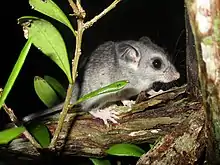Big-eared climbing rat
The big-eared climbing rat (Ototylomys phyllotis) is a species of rodent in the family Cricetidae. It is found in Central America from Mexico to Costa Rica.
| Big-eared climbing rat | |
|---|---|
 | |
| Scientific classification | |
| Kingdom: | Animalia |
| Phylum: | Chordata |
| Class: | Mammalia |
| Order: | Rodentia |
| Family: | Cricetidae |
| Genus: | Ototylomys Merriam, 1901 |
| Species: | O. phyllotis |
| Binomial name | |
| Ototylomys phyllotis Merriam, 1901 | |
Description
The big-eared climbing rat is in the order Rodentia and in the family Cricetidae and is most widely distributed species in the genus Ototylomys. A second species of the genus was described in 2017 from the Mexican state of Chiapas.[2] The genus dates back 3.35 Mya, prior to the Great American Biotic Interchange and Its initial occurrence was near Honduras and El Salvador.[3]
Ototylomys is Greek for otus (ear), tylos (knob, knot, swelling), and mus (mouse), which describes the animals large ears and shelf-like skull.[4]
The big-eared climbing rat is a slender rat with two colors; dark on top of its body and light below. Its eyes and ears are large. It has large naked ears and a long naked tail with scales. Its size and color varies depending on where it lives geographically but most populations have a creamy white underbelly except for those in Mexico and Guatemala, which have a slate-colored underbelly. The skull is flat on top and has a prominent interparietal bone and supraorbital ridges There is no sexual dimorphism in this species.[5]
Phylogeny
The genus Ototylomys is most closely related to Tylomys. They both are known as climbing rats that are endemic to Central America. They both have flattened braincases, elongated skulls, highly developed supraorbital ridges and incisive foramina. They also have similar reproductive glands. They differ in many traits some being that Ototylomys are smaller with larger ears. They also have a larger auditory bullae, their rostrum is narrower, and their baculum is longer and narrower compared to its size.[4]
Distribution and habitat
This species ranges from Mexico to Costa Rica.[5]
Diet
The diet of the big-eared climbing rat is still incomplete but it mostly consists of fruit and leaves. We know their dietary needs are very not well known because the big-eared climbing rats that have been successfully housed in laboratories often have their tails fall off due to malnutrition.[5]
Behavior
Big-eared climbing rats are arboreal and nocturnal and they are seen both on the ground and in the trees. Their copulatory behavior is peculiar in that there is a copulatory lock.[5]
Physiology
There does not seem to be a regular estrous cycle. The gestation length of the big-eared climbing rat is 52 days. Delayed implantation may occur in this species. The females exhibit post-partum estrus and the litter size may vary from 1-4.[5]
From birth, newborns have been observed to be very advanced for their age. They chased their mothers almost from birth and by day 2 they are already 50% of the adults body length and respond to loud noises. By day 6 they open their eyes and they cling to their mothers teats for 30 days. Timing of sexual maternity varies within this species.[5]
The big-eared climbing rat has been a subject of study due to a disease caused by Leishmania (L.) Mexicana. This is an intracellular parasite that infects these rodents and makes them a good model choice for further research on this topic.[6]
References
- Reid, F. & Timm, R. (2016). "Ototylomys phyllotis". IUCN Red List of Threatened Species. 2016: e.T15666A115129272. doi:10.2305/IUCN.UK.2016-3.RLTS.T15666A22356249.en.{{cite iucn}}: error: |doi= / |page= mismatch (help)
- Porter, Calvin A.; Beasley, Nia E.; Ordoñez-Garza, Nicté; Lindsey, Laramie L.; Rogers, Duke S.; Lewis-Rogers, Nicole; Sites Jr., Jack W.; Bradley, Robert D. (2017). "A new species of big-eared climbing rat, genus Ototylomys (Cricetidae: Tylomyinae), from Chiapas, Mexico". Journal of Mammalogy. 98 (5): 1310–1329. doi:10.1093/jmammal/gyx096. PMC 5901089. PMID 29674786.
- Gutiérrez-García, T. A.; Vázquez-Domínguez, E. (2012). "Biogeographically dynamic genetic structure bridging two continents in the monotypic Central American rodent Ototylomys phyllotis". Biological Journal of the Linnean Society. 107 (3): 593–610. doi:10.1111/j.1095-8312.2012.01966.x.
- Lawlor, T. E. (1969). "A systematic study of the rodent genus Ototylomys". Journal of Mammalogy. 50 (1): 28–42. doi:10.2307/1378627. JSTOR 1378627.
- Lawlor, T. E. (1982). "Ototylomys phyllotis". Mammalian Species. 181: 1–3. doi:10.2307/3503849.
- Van Wynsberghe, Nicole R.; Canto-Lara, Silvia B.; Damián-Centeno, Alma G.; Itzá-Ortiz, Mateo F.; Andrade-Navárez, Fernando J. (2000). "Retention of Leishmania (Leishmania) mexicana in Naturally Infected Rodents from the State of Campeche, Mexico". Memórias do Instituto Oswaldo Cruz. 95 (5): 595–600. doi:10.1590/s0074-02762000000500001. PMID 10998205.
